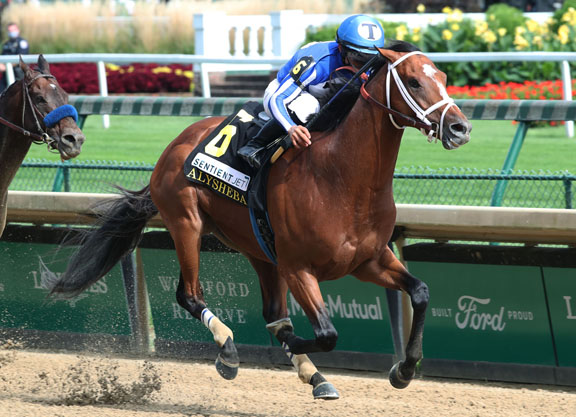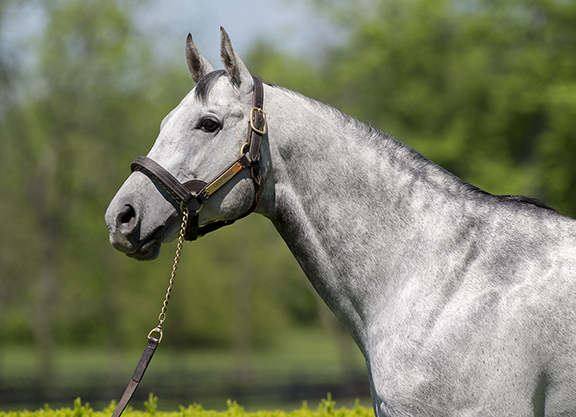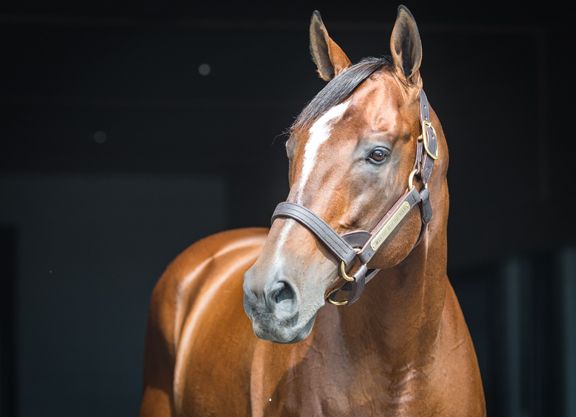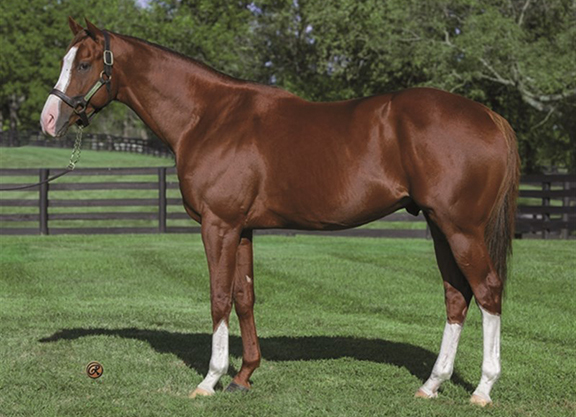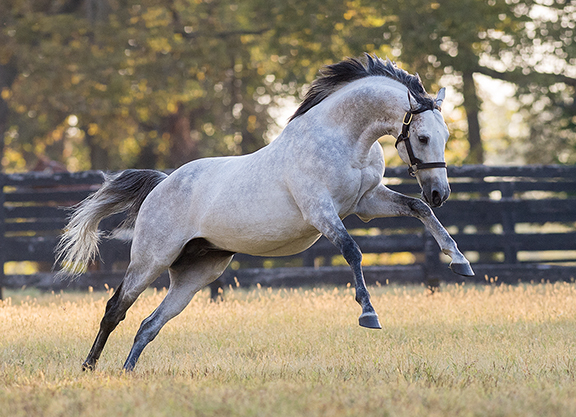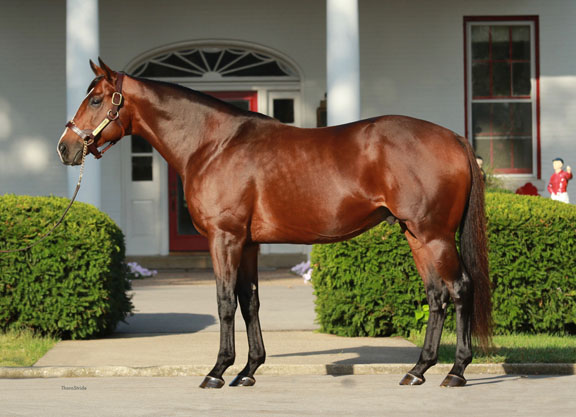It tells you plenty about the business today that this final leg of our quest for value on Kentucky farms should compress together stallions whose various retirements from the racetrack spanned more than decade. In devoting nearly all the previous instalments to individual classes of younger stallions, we've simply mirrored the distribution of mares, which as we all know is massively loaded towards largely unproven sires. To me, then, those few survivors that do establish a viable niche in the Bluegrass are real heroes.
While dozens of their original competitors have been banished to regional or overseas theaters, they have battled their way through and now contest a rather different market. Typically it will be oriented to those rare programs that can either afford to pay the top fees, for the likes of Into Mischief and Tapit, or at least take a longer view on building up families.
So today we must confront head-on the claim that drives so much commercial traffic towards new stallions that will, in the majority of cases, turn out to be standing at career high fees. And that's the idea those few sires that earn the label “proven” tend to become so expensive that investors have no choice but to roll the dice on relatively affordable rookies, hoping to hit a Gun Runner on the way up.
To a degree, of course, that consensus creates its own validity. Commercial breeders know where to anticipate ringside interest and as a result a stallion's debut book, very often, will prove the best he will ever assemble.
Putting that reality to one side, however, I do feel skeptical about the basic premise. For one thing, agents and managers almost invariably back off stallions as soon as they have cycled through their debut crops, long before they have had a meaningful chance to demonstrate whether or not their stock can actually run. But the principal point, and the object of the exercise today, is that there are actually plenty of stallions out there you could describe as both “proven” and affordable.
Despite career stats that will remain far beyond the vast majority of those newcomers annually flooding the gene pool, more likely than not with mediocrity, many of these stalwart operators tend to suffer flagrant commercial neglect. Their books are modest, whether measured by quality or quantity, and unsurprisingly the same then proves true of their sales dividends.
Hence, in turn, their accessible fees. That does mean that some of the horses we highlight today will seldom appeal to a fast-buck commercial breeder. But I'll keep saying it: there should be nothing more commercial than putting a winner under your mare.
So I have every confidence that in this final wrap we're not only looking at some of the worthiest stallions around, but at some of the best value as well. And because of the sheer range of this final group, we'll include rather more than usual in our round-up of near-misses.
The whole process, of course, has represented no more than one more opinion in a massively subjective environment. A ton of deserving stallions will have been overlooked; perhaps even entire farms. But nobody knows better than you what might work for your particular mare, and your particular program.
Many of the choices I've made are based on principles that a lot of people will consider impractical. When I suggest that you can get value from sires whose stock may need time to mature, and a second turn, then I absolutely accept that a lot of people need (and really “need”, as opposed to “prefer”) to get paid sooner and better than that will typically allow. Equally, however, I'm not going to flag up stallions that corral 400 mares in their first two seasons and then get their vaunted black-type action at only a pedestrian rate.
The nature of this particular beast means that we will be revisiting some old pals here. A body of work extending over several years is hardly invalidated by a single quiet one. And, as I've said before, there's no vice harder to overcome than that of being too stubborn!
BUBBLING UNDER:
I hate to admit it, but commercially the game does appear to be up with my old favorite LOOKIN AT LUCKY. It tells you everything about the unwholesome way the business is skewed that he can sire winners of America's two most iconic races and still be reduced to a fee of just $10,000. His scandalous neglect does have one benefit, however, for breeders far-sighted enough to “prove” a young mare inexpensively.
Even now his neighbor Munnings—launched simultaneously but long a darling of the sales ring, now commanding a fee 10 times higher than Lookin At Lucky–cannot beat his elite footprint. Both have 13 Grade I performers, but it is Lookin At Lucky who has produced them at a superior percentage (and, of course, from far inferior opportunity). “Lucky” should be gold on the value podium every year, but there would clearly be no point by this stage. All we can do is hand over the baton on to his big-value sons Accelerate and Country House.
MIDSHIPMAN, another podium regular, has in contrast finally had his remarkable data acknowledged by the doubling of his fee to $20,000. Somehow he can't quite crack that Grade I ceiling, but maintained his astounding consistency at black-type level in 2022, with 25 such performers representing 10.7 percent of starters. He'll have to work harder to achieve the
same profitability from his new fee, having soared to an average of $65,687 (median $50,000) for yearlings conceived at just $8,500, but hopefully his mares will also be upgrading now. What an exemplary horse! He's been a gift for so long, but I am confident he will keep on giving.
MIDNIGHT LUTE almost achieved the same stakes footprint last year, at nine percent of starters–just shy of his lifetime clip, which has yielded 41 stakes winners including five at Grade I level. These are obviously headed by Midnight Bisou, but we have long since established that this is no one-trick pony. Midnight Lute really has a tremendous output for a horse standing at $12,500 and is another to mock the notion that there are no “proven” stallions out there within reach of the ordinary breeder. He looks after his clients respectably at the sales, too.
Even better stats back up SKY MESA, another whose resumé will remain far beyond the competence of the vast majority of rookies annually launched at much steeper fees than $10,000. Even among “proven” sires, you'll find quite a few at much higher tariffs that can't better Sky Mesa's lifetime 12.5 percent stakes performers-to-named foals.
Another struggling for due respect at $7,500 is FIRST SAMURAI, who nonetheless got on with business as usual in 2022 with another seven stakes winners. His buddy BLAME did not quite meet his own high standards, and rather feels due another star, but he has long demonstrated an ability to recycle his class at a rate better than his $25,000 fee. With that aristocratic pedigree behind him, I've always thought Blame highly eligible to become a distaff influence and so it is already proving. Two of the very best juveniles of 2022, Forte (Violence) and Loggins (Ghostzapper), are both out of Blame mares—surely a hugely significant straw in the wind.
BRONZE: CROSS TRAFFIC (Unbridled's Song–Stop Traffic by Cure The Blues)
$7,500 Spendthrift

Cross Traffic | Spendthrift Farm
To be honest, this lad is not quite in “proven” territory just yet, belonging as he does to the intake immediately preceding the three we grouped together last time as still “earning their stripes”. Even so, it feels like he has been around for quite some time: in his relatively short career he has managed to squeeze in some dazing fluctuations in fortune. He finds himself at another crossroads now, but the fact is that he has just confirmed (for a second time) his ability to punch above this kind of fee.
As champion freshman by multiple indices in 2018, the gray was hoisted to $25,000 for 2019 and duly received a stampede of 188 mares. The resulting crop were juveniles of 2022 and drove a spirited comeback in the all-comers' table of 2-year-old sires. Though this category was conspicuously dominated by freshmen, his 33 individual winners from 79 starters put him second overall; while his 13 black-type juveniles represented a knockout ratio of starters, surpassed in fact only by his latest successor as champion freshman, Bolt d'Oro, and the six-figure covers Quality Road and Constitution.
His four juvenile stakes winners included one unbeaten in both starts at Saratoga, and a filly that flew late into fourth at the Breeders' Cup. But despite doubling down on a reputation for precocity, Cross Traffic's stock is actually entitled to keep building. His principal earner to date, Ny Traffic, won over $900,000 across four campaigns, and remember that Cross Traffic himself only raced as a 4-year-old, when making up for lost time with a GI Met Mile second and GI Whitney success on only his fourth and fifth starts.
He has some pretty exotic names seeding the bottom line, but that certainly hasn't stopped the big horse on this farm and it felt auspicious that Cross Traffic actually elevated his yearling average in 2022 to $43,250 from $29,019, reversing a bleakly familiar trend at this stage of a stallion's career. Unfortunately his books have quickly dwindled since his renewed vogue in 2019, but his juvenile returns in both 2018 and 2022 show what he can do if given a chance—which is surely just what he deserves at this kind of basement fee.
Incidentally, a word here for his studmate JIMMY CREED, who struggled somewhat commercially with his last yearlings but counted dual Grade I winner Casa Creed and GI Breeders' Cup Juvenile Turf Sprint third Private Creed among his seven stakes scorers in 2022. His book numbers have held up healthily over the past couple of years and there's a corresponding sense that he has more to offer at just $10,000.
SILVER: HARD SPUN (Danzig–Turkish Tryst by Turkoman)
$35,000 Darley
Okay, so he had no real headliner in 2022—dropping out of the top 10 in the general sires' list for the first time in four years—but his customary foil Street Sense ($75,000) was nonetheless the only stallion standing for under six figures to beat 11 stakes winners. In other words, Hard Spun maintained his customary consistency and, moreover, boosted his yearling average to $109,187 from $80,353 the previous year.
That gives a commercial dimension to his principal appeal as the most accomplished sire of runners around at this kind of fee. Hard Spun stands as high as eighth in the earnings table of active American stallions, just ahead of his longstanding accomplice Street Sense. Their ratios across all indices are uncannily similar, for horses who first crossed swords on the track and at one stage even shared a sojourn in Japan together. As Street Sense himself is widely respected as pretty fair value at $75,000, it's remarkable that you can still get to Hard Spun for less than half that fee.
As a parting gift of the breed-changing Danzig, he has duly parlayed that international influence into many different theaters—short, long; dirt, turf—and he is already proving a notable broodmare sire. That's no surprise, when he complements Danzig with all that Darby Dan royalty down the bottom line.
Sure, much like our gold pick, Hard Spun's youngsters tend not to be the most precocious. But they are worth the wait. That capacity to carry speed, after all, is supposedly the grail for breeders. Though he later landed the GI King's Bishop over seven furlongs, Hard Spun held out for second in Street Sense's Derby after setting a pace that left the eventual winner, third and fourth, respectively, in 19th, 13th and 20th after half a mile.
It's a mystery, really: Hard Spun was standing at $60,000 before his year in Hokkaido, and he dominated the fourth-crop sires' table during his absence (ahead of Street Sense, English Channel and Scat Daddy), yet has never since restored his fee to its due level. You wouldn't catch me complaining about that, however, if I had a worthy mare.
GOLD: SPEIGHTSTOWN (Gone West–Silken Cat by Storm Cat)
$80,000 WinStar
So what better way to finish a project like this, where you cannot fail to offend more people than you please, than with a truly provocative pick!?
But while I, too, would love to live in a world where $80,000 feels like a bargain, then we have to accept that value is a relative concept. And, for those folks who really can afford to send a mare to the elite sires, then here's a fee that brings to mind the old advertising slogan: “Hurry while stocks last!”
This is a game of opinion and I absolutely respect your right to share the prejudice against ageing stallions and mares. To me, even so, it has a self-fulfilling quality. The most expensive sires gradually find themselves in competition with their own sons—who start out not only with all the customary freshman fanfare, and a recency bias, but generally at a more accessible fee. Nonetheless there are copious examples of champion runners and important influences (including the one on the second step of this podium) being delivered very late in the career of their sire and/or dam.
As a very late starter (aged seven) at stud, of course, Speightstown has not had quite as exhausting a love life as his peers: Tapit, for instance, is three years younger but has 1,567 named foals against 1,344 for Speightstown. And the WinStar stalwart evidently remains as potent a genetic influence as ever, with nine new Grade I winners over the last three years.
Take the two most expensive stallions among his established rivals, Into Mischief ($250,000) and Curlin ($225,000). At those fees, they must be man enough to stand comparison. Speightstown has maintained his 130 stakes winners at 9.7 percent of named foals (Into Mischief 8.6 percent, Curlin 8 percent); graded stakes winners at 4.6 percent (Into Mischief 4.1 percent, Curlin 4.5 percent); and his 24 Gråade I winners represent 1.8 percent, exactly the same as Curlin with Into Mischief (obviously started from a lower base of mares) on 0.9 percent.
At this rarefied level, the only pair who can shade Speightstown's ratios are the ever-freakish Tapit, who costs more than twice as much; and War Front, who has always hit incredible percentages but from unusually selective books for this day and age. And while War Front himself arguably now represents value at $100,000, the fact is that some such surgery to his fee had become imperative after his 2022 yearlings, conceived at an eye-watering $250,000, couldn't redeem that sum either by average or median.
Speightstown's latest crop of yearlings, in contrast, averaged $229,450 on a conception fee of $70,000. Having for several years routinely been a six-figure cover, he was hiked back up to $90,000 for 2021 and 2022 as the elite winners just kept on coming. But he has taken a friendly trim this year and, in this giddy context, he looks authentic value for a stallion who now has Olympiad joining half a dozen other sons at stud in Kentucky.
One of those, Munnings, has now overtaken his sire in fee. Pending the testing of Jack Christopher, however, Munnings can hardly be called an established sire of sires as yet; whereas Speightstown has now been in the game long enough to be launching stallions out of his daughters (Vekoma, Laoban, Aloha West) as well.
If this seems an even eccentric way to conclude this series, so be it. But this horse, surely, is an influence that we can all agree on: commercial breeders, pinhookers, end-users. He had the physique and pedigree to cost $2 million as a yearling and duly poured on the speed on the main track. Yet he was also better than ever at the age of six, and has diversified his legacy in terms of distance and surface. His three latest Grade I winners sum him up perfectly, in tests as diverse as the Jockey Club Gold Cup, Dubai Golden Shaheen and Maker's Mark Mile.
The one dimension he has admittedly lacked is precocity, but I would trade that for his old-school soundness. He gets a stellar 83.3 percent of named foals into the starting gate, and narrowly shades even Tapit with 63.5 percent also proceeding to the winner's circle. (To pick on a couple of other stallions standing at fees that require them to face the music: Quality Road ($200,000) gets 56.6 percent winners to named foals; and Uncle Mo ($150,000) 47.1%.)
Speightstown is now 25 and must surely be nearing the final stretch of a storied career. But just think about the great names he compresses to our reach, as a result: first three dams by Storm Cat, Chieftain and Buckpasser. He has retained the vigor to serve 199 mares across the last two seasons and, if you have that kind of money, being granted one of his final audiences would be a privilege beyond price.

The post Value Sires For ’23: Part VII, Established Sires appeared first on TDN | Thoroughbred Daily News | Horse Racing News, Results and Video | Thoroughbred Breeding and Auctions.
Source of original post




